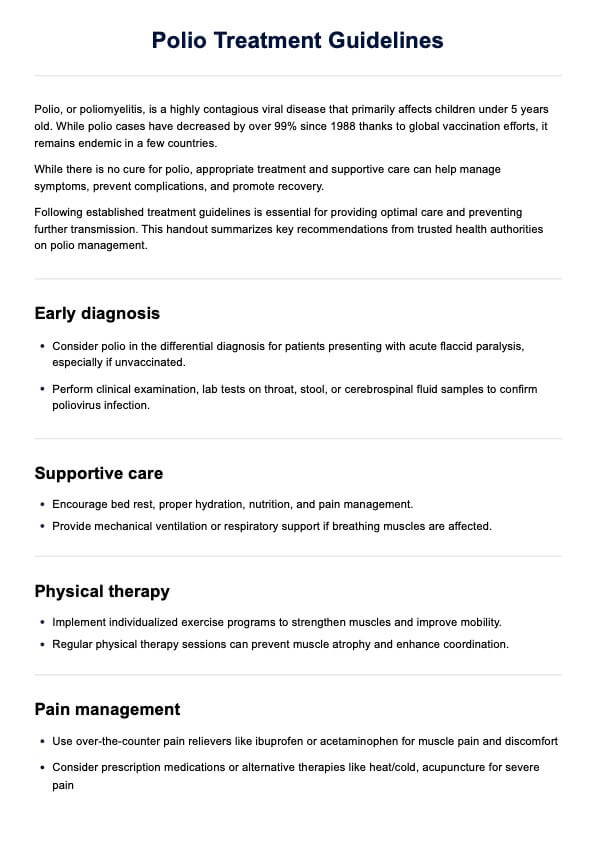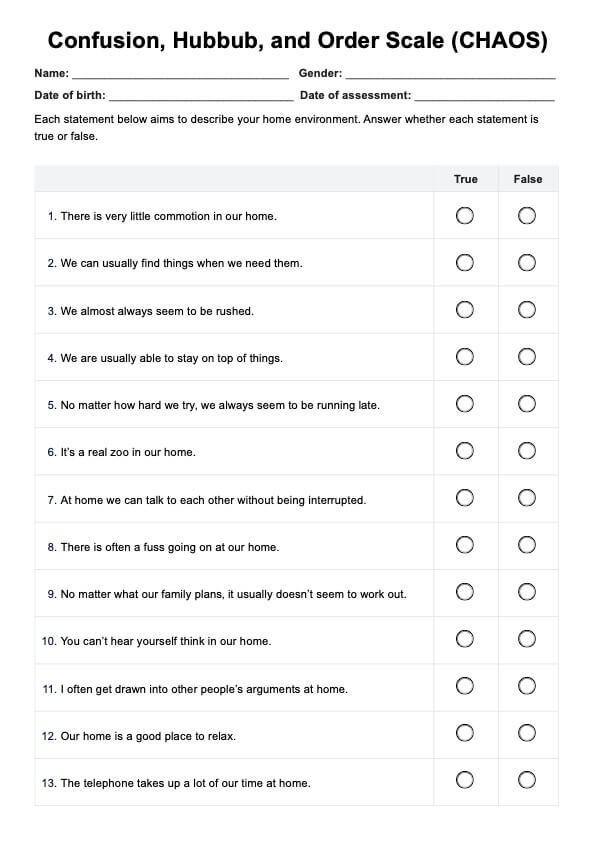Polio Treatment Guidelines
Learn about polio and how to manage this condition. Download a free Polio Treatment Guidelines handout from Carepatron.


What is polio?
Polio, short for poliomyelitis, is a highly infectious viral disease caused by the poliovirus. It primarily affects young children under the age of 5 and can lead to paralysis or even death.
This disease was once a global epidemic, affecting millions of individuals and causing widespread fear and panic. However, the development of successful vaccines, polio spread has now been eradicated in most parts of the world (Polio Global Eradication Initiative, 2019).
As mentioned, polio is caused by the poliovirus, which enters the body through contact with infected feces or mucus from the nose or throat of an infected person. It can also be spread through contaminated food or water. The virus then multiplies in the intestines and can move on to attack the nervous system.
The virus mainly affects motor neurons in the spinal cord and brainstem, leading to muscle weakness and paralysis. In some cases, it can also cause breathing difficulties and can be life-threatening if the muscles that control breathing are affected.
Polio symptoms can vary from mild flu-like symptoms to paralysis in one or more limbs. In severe cases, it can lead to permanent disability or death.
Polio Treatment Guidelines Template
Polio Treatment Guidelines Example
Polio treatment
While there is no cure for polio, various treatments can help manage symptoms, improve quality of life, and promote recovery. Below are key components of polio treatment that can aid patients on their journey to regaining strength and function:
Physical therapy
Physical therapy plays a crucial role in the rehabilitation process for polio survivors. Specialized therapists assess each patient’s needs and develop individualized exercise programs tailored to strengthen muscles and improve mobility.
These programs often combine stretching, strengthening exercises, and functional training to help patients regain strength and enhance their overall physical capabilities. Regular physical therapy sessions can also help prevent muscle atrophy and improve balance and coordination.
Pain management
Managing pain is an essential aspect of polio treatment, especially for those experiencing discomfort from muscle weakness or spasms. Over-the-counter pain relievers, such as ibuprofen or acetaminophen, can relieve pain and discomfort.
In more severe cases, healthcare providers may prescribe stronger medications or recommend alternative therapies, such as heat or cold therapy, acupuncture, or relaxation techniques to help alleviate symptoms.
Braces and orthotics
For individuals experiencing weakness in their limbs, braces or orthotic devices can offer crucial support. These devices help stabilize weak joints, improve mobility, and enhance overall functionality.
Orthotic interventions may include ankle-foot orthoses (AFOs), knee braces, or custom-made shoes designed to fit the individual’s specific needs, allowing for greater independence in daily activities.
Respiratory support
In more severe cases of polio, where the muscles responsible for breathing are affected, respiratory support becomes critical. This may involve mechanical ventilation to assist with breathing or non-invasive options like bilevel-positive airway pressure (BiPAP) machines. Ongoing monitoring and support from healthcare professionals are essential to ensure patients receive the necessary care to maintain adequate respiratory function.
Polio vaccine
Polio vaccination remains the best prevention strategy. Inactivated poliovirus vaccine (IPV) and oral poliovirus vaccine (OPV) are highly effective in stimulating the immune system to fight the virus. Widespread vaccination efforts have significantly reduced the incidence of polio, making it crucial for children and at-risk populations to receive polio vaccines for effective disease control. Recognizing the symptoms of polio and understanding how polio spreads is essential for prevention efforts.
While polio can have lasting effects, a comprehensive treatment approach that includes physical therapy, pain management, supportive devices, respiratory care, and inactivated polio vaccine can significantly improve the quality of life for those affected.
How to use our treatment guidelines handout template?
Our Polio Treatment Guidelines handout is designed to be a comprehensive resource for healthcare professionals, public health workers, and family caregivers. Here's how to use it:
Step 1: Download the resource
Get a copy of the Polio Treatment Guidelines template using the link on this page. You can also download it via the Carepatron app.
Step 2: Print or use electronically
You can print out the guidelines handout template for easy access and reference, or you can use it digitally on your computer or tablet.
Step 3: Familiarize yourself with the content
Take some time to read through the guidelines and familiarize yourself with the information provided. Make sure to pay attention to the specific sections that may be relevant to your needs.
Step 4: Customize as needed
The guidelines handout template is designed to be a customizable tool. You can add your own notes, highlight important information, and even insert additional resources or references.
Step 5: Share with others
Our goal is to provide valuable resources for healthcare professionals and caregivers. We encourage you to share the guidelines handout with colleagues, patients, and anyone else who may find it useful.
How can healthcare professionals benefit from our template?
Healthcare professionals can benefit greatly from the Polio Treatment Guidelines handout in several ways.
Better patient care
The handout provides clear, evidence-based information that helps ensure patients receive the best care possible. This easy access to information helps healthcare providers give high-quality care and improve patient safety.
Streamlined consultations
The handout serves as a quick reference tool during patient visits. It highlights key information on treatment and management of polio. This makes it easier for healthcare professionals to make decisions and ensures they don’t miss any important steps during consultations.
Training and education
The handout is also useful for training healthcare staff and caregivers on standard treatment options for polio. By using it in training sessions, healthcare facilities can ensure that everyone understands their roles in managing polio cases. It helps new staff learn the latest best practices quickly.
Commonly asked questions
One of the most effective ways to treat polio virus is through vaccination. Routine immunization for all children against poliovirus, starting from infancy is recommended. Oral polio vaccine and inactive polio vaccine are two types of vaccines used to protect against poliovirus.
Most people who contract polio virus will experience mild symptoms and fully recover without any long-term effects.
While there is currently no cure for post-polio syndrome (PPS), there are various treatments that can help manage its symptoms. These may include physical therapy, occupational therapy, medication for pain and fatigue, and assistive devices such as braces or wheelchairs.
Post-polio syndrome (PPS) is believed to occur due to the degeneration of motor neurons in the spinal cord, which can result in muscle weakness, fatigue, and pain. It can also affect the brain’s processing related to motor control, leading to complications in mobility and muscle coordination.
Yes, muscle pain associated with polio or post-polio syndrome can often be managed through a combination of physical therapy, medications for pain relief, and lifestyle adjustments tailored to minimize strain on affected muscles.

.jpg)





































































































